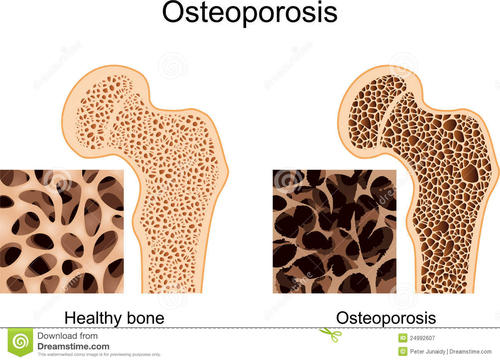Have you seen some chaff radishes? Radish hearts will become hollow and spongy due to long storage time.
After osteoporosis, human bones will turn into chaff like carrots. Unsteady walking, broken bones and other health problems will also follow.
The performance of "Chaff" in bone degeneration
* Osteoporosis can cause chest tightness, hunchback, bone pain, fractures, etc. Even minor external forces, such as coughing, sneezing, and lifting heavy objects, may cause fractures.
 If you have the following six manifestations, your bones may be shattering.
1back pain
Bone pain is the most common manifestation of osteoporosis. Pain during the initial activity, and then develops into persistent pain in the later period.
2 becomes shorter
If the height is shortened by more than 3 cm, it is suspected to be osteoporosis, mainly caused by vertebral compression fractures.
Humpback is also a risk indicator of osteoporosis. The height of 65-year-old hunchback can be shortened by 4 cm, and the height of 75-year-old can be shortened by 9 cm.
3 fracture
Even if there is no obvious external force, fractures may occur. Among them, the wrist, spine, and buttocks are the easiest to hit.
4 Loose teeth
The decrease in bone density will make the alveolar bone weak. When you reach middle age, you have no dental disease, but your teeth begin to loosen. You should be vigilant.
5 steps
After osteoporosis, the body\'s balance ability decreases, and the body becomes unstable when standing or walking, which is an important warning signal.
6 Difficulty breathing
Unlike breathing disorders caused by lung infections, dyspnea caused by osteoporosis is usually not accompanied by coughing, elevated body temperature and respiratory inflammation.
Three strokes to slow the bones
In fact, osteoporosis can be prevented and treated. Through "early prevention, early detection, and early treatment", the speed of bone becoming "chasm" is delayed.
1. Enough scientific movement
Moderate mechanical stimulation can slow down bone loss, but more exercise does not mean that all exercises can achieve the desired results.
Exercises that cannot increase bone density: cycling, swimming, etc.
Bone physiotherapy exercise that helps increase bone density: aerobic exercise load.
Young people can do some high-intensity sports, such as skipping, 3-6 days a week, about 50 times a day, about 8 cm above the ground; jogging, at least 2-3 times a week, 20 minutes each time, do not pursue speed .
The elderly can walk briskly, three days a week, 45-60 minutes a day, and they can walk briskly and slowly.
If you have the following six manifestations, your bones may be shattering.
1back pain
Bone pain is the most common manifestation of osteoporosis. Pain during the initial activity, and then develops into persistent pain in the later period.
2 becomes shorter
If the height is shortened by more than 3 cm, it is suspected to be osteoporosis, mainly caused by vertebral compression fractures.
Humpback is also a risk indicator of osteoporosis. The height of 65-year-old hunchback can be shortened by 4 cm, and the height of 75-year-old can be shortened by 9 cm.
3 fracture
Even if there is no obvious external force, fractures may occur. Among them, the wrist, spine, and buttocks are the easiest to hit.
4 Loose teeth
The decrease in bone density will make the alveolar bone weak. When you reach middle age, you have no dental disease, but your teeth begin to loosen. You should be vigilant.
5 steps
After osteoporosis, the body\'s balance ability decreases, and the body becomes unstable when standing or walking, which is an important warning signal.
6 Difficulty breathing
Unlike breathing disorders caused by lung infections, dyspnea caused by osteoporosis is usually not accompanied by coughing, elevated body temperature and respiratory inflammation.
Three strokes to slow the bones
In fact, osteoporosis can be prevented and treated. Through "early prevention, early detection, and early treatment", the speed of bone becoming "chasm" is delayed.
1. Enough scientific movement
Moderate mechanical stimulation can slow down bone loss, but more exercise does not mean that all exercises can achieve the desired results.
Exercises that cannot increase bone density: cycling, swimming, etc.
Bone physiotherapy exercise that helps increase bone density: aerobic exercise load.
Young people can do some high-intensity sports, such as skipping, 3-6 days a week, about 50 times a day, about 8 cm above the ground; jogging, at least 2-3 times a week, 20 minutes each time, do not pursue speed .
The elderly can walk briskly, three days a week, 45-60 minutes a day, and they can walk briskly and slowly.
For people at risk of fractures, jumping, bending the spine and carrying heavy objects should be avoided.

2. Supplement calcium and vitamin D from food
① Calcium supplement: bone "supporter"
Milk is rich in calcium and has a high absorption rate. It is recommended to drink 300 grams of liquid milk every day. In addition, germ rice, green leafy vegetables, salmon, sardines, cheese and tofu also contain calcium.
② Vitamin D: bone supplement
Vitamin D can promote the absorption of calcium in the intestines and reduce the excretion of calcium in the kidneys, just like a gas station, which continuously supplements the bones with calcium.
10% of the vitamin D in the human body is obtained from food. It is recommended to eat fungus rice, egg yolk, mushrooms, lean meat, seafood, animal liver and nuts.
3. Bone mineral density determination for people over 40 years old
People over 40 should have a bone density test. If necessary, they should follow the doctor\'s advice and take anti-osteoporosis drugs and vitamin D.

